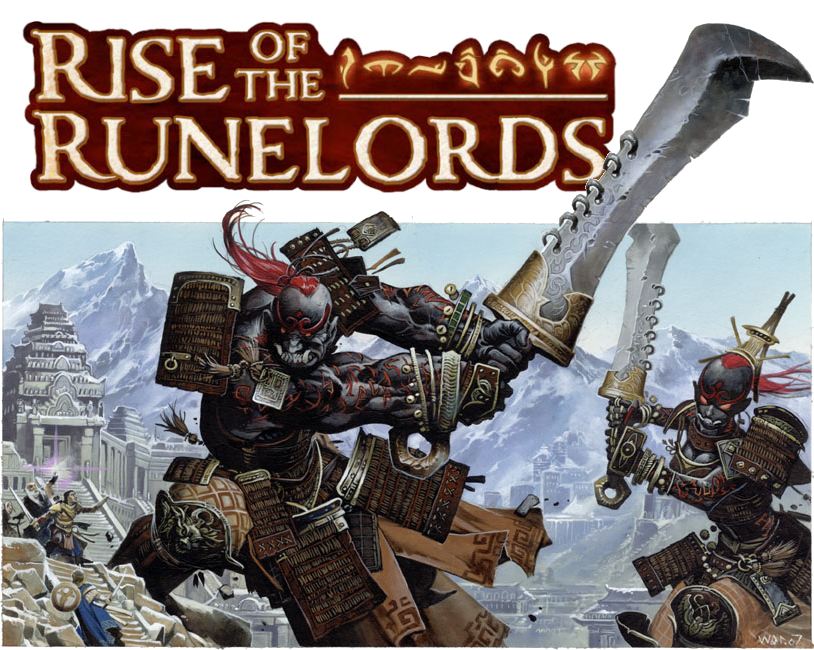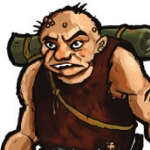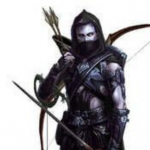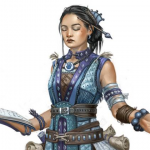Spires of Xin-Shalast – 0

The Spires of Xin-Shalast is the sixth and final part of the Rise of the Runelords adventure path for Pathfinder. It is designed to take characters from 15th to 17th level, so is quite high level in terms of character capability and opponent complexity. Since I’m running this, rather than playing this, these posts will be notes from a GM’s perspective. Since my players may well be reading them, they won’t contain spoilers for anything that the players don’t yet know, but will contain some notes and ideas of what I’ve changed from the adventure as written, and my thoughts on what’s worked and what hasn’t.
It’s been about nine months since we played the previous instalment of the adventure path, so remembering what happened and where everyone needs to go next was going to be a problem. The last session concluded in Runeforge, with one dominant weapon enchanted ready to use against the Runelord of Greed Karzoug. The party needs to decide what other weapons they want to enchant with Runic properties, and which properties they want to take.
To complicate matters, one of the players has left (to go on real world adventures around the world), leaving the party without a cleric. One player has decided to swap out their existing character (a paladin/sorcerer/dragon disciple) for a cleric – so only three characters from the original party will be around. The first part of the adventure needed to introduce the new character, as well as point everyone in the right direction.
Characters
A party of five (six if you include the original Cleric’s companion) has now become a part of four. A quick rundown of the new adventuring group is as follows. All are now 15th level.

Esheire, a sorceress of the Rakshasa bloodline most noted for her general lack of suitable clothing. She is a powerful enchantress, but can also use death spells on things she can’t charm and just burns the rest. She is one of the two characters that became aligned with a Sin – as it turns out not Lust as was probably assumed by everyone, but Sloth. As a GM, Esheire can really complicate things through the use of enchantment effects such as Dominate Person or Mass Suggestion.

Grodok, a fighter most noted for his general lack of intelligence and ever expanding waistline due to his love of pies. Grodok was unsurprisingly aligned to Gluttony. He is a simple character, but very heavily optimised to hit things and kill them through the massive application of physical damage. Basically, any physical threat he can get to doesn’t survive long, which has sometimes made making things a challenge difficult at times, so I’ve taken to giving boss creatures maximum hit points (at +1 CR). This means they last maybe three rounds rather than two.

Solassar is a fairly typical human rogue scout, using two weapons in melee and a bow at range. Highly skilled at stealth and perception, he has been the group’s only real stealthy character for a long time and will now probably be the only other front line fighter. Now he’s equipped with ghost touch weapons, he can use his sneak attack ability on incorporeal creatures as well. I’m expecting him to be quite useful in helping to actually find the lost city, since he’s also the only character with decent wilderness skills.

Serena, a cleric / Pathfinder Savant, is a new character to the group so I have no idea how she is going to play out. She seems to be focused on summoning a Zuishin Kami to provide healing ability. The player has a tendency to build very non-standard characters (from a mechanical perspective), which is fine, but can sometimes make it difficult to figure out where the character fits in the group.
A Recap
To help jog everybody’s memories, I provided a handout to recap what has happened and to detail what the options are for making Runeforged weapons. Included, were the final words of Karzoug to the party at the end of the last session, as his animated statue was destroyed:
This… this is not the last… come then, heroes. Seek me atop Mhar Massif, if you value life so poorly. You should be honoured to be the first fools executed under the banner of Shalast in ten thousand…
There were also some reminders of what they already knew:
- Xin-Shalast is located on the towering mountain of Mhar Massif, in a valley that lies at the headwaters of the mythical River Avah.
- Mhar Massif itself is said to serve as a bridge to strange realms beyond Golarian.
- Anyone who can find the mythical River Avah can follow it directly into Xin-Shalast.
- None of you know where the River Avah can be found.
The next part of the adventure is to confront Karzoug, and to do that they need to find his lost city. The thing about lost cities though, is that they’re, well, lost, and nobody knows where they are. The question of where to go next then will be an important one, so I’ve also reminded them of potential sources of information which may help point them on the right path:
- The sage Brodert Quink in Sandpoint.
- The library at Jorgenfist (though must useful information has been found here).
- Various things you found in Runeforge, available as handouts.
So the players have a reminder of what’s happened, and have some clues to possibly follow up to find out where they need to go next. First though, since it’s been nine months, I decided to throw in a mini-adventure to get everyone back into the feel of their characters, and to also introduce the new character. As a background reason for why the other two characters have left the group, I mentioned that they were called away by Iomodae to help at the Worldwound.
A further complication is that Rise of the Runelords was designed to use the fast experience progression. During the third chapter, I switched to medium progression, to give me the opportunity to put in some side adventures on the way. Since the characters need a lot more experience to reach suitable levels (and this becomes more important now they are down to four), adding in some extra side quests is needed. So this first adventure will serve a number of purposes:
- Provide a boost to the experience that character’s have, so they’ll reach the right levels at the right times. The adventure path is quite railroaded in this regard, but that hasn’t been too much of an issue since the players knew this before they started.
- Remind everyone how to play their characters. The group has been doing another adventure path (Strange Aeons) for the last couple of months, so remembering Pathfinder shouldn’t be an issue, remembering what skills and abilities their characters had might be.
- Provide some clues to help point the party in the right direction and give them a head’s up on timescales (given half a chance, most parties in Pathfinder will happily spend weeks shopping and making new items rather than pursuing the rather important goal of saving the world).
- Introduce some mechanics I plan to use for the main adventure when trying to find the lost city of Xin-Shalast. This will give me a chance to debug it before using it for real.
- Provide some background flavour and foreshadowing of what is to come.
So the first session will begin right where the last one left off, which means I’ll need to push everyone towards the mini adventure quite quickly – if for no other reason that otherwise one player will be out of the action until their new character Serena is introduced. I’ve run enough open world sandbox games in my time to not feel guilty about doing the odd railroad on occasion.
The next instalment will detail the first mini-adventure, and maybe discuss how it went (I’m expecting it to last one session, but such things can be difficult to predict).